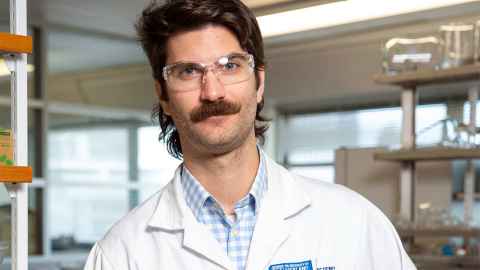Methamphetamine detected in downtown Auckland air pollution
17 April 2023
Meth, nicotine, caffeine and THC detected in Customs Street air in groundbreaking study.

Methamphetamine, nicotine, caffeine and tetrahydrocannabinol (THC) were detected in downtown Auckland air in the first study of its type in New Zealand and Australia.
Traces caught by filters at a pollution monitoring site on Customs St near the bottom of Queen St were analysed by scientists from Waipapa Taumata Rau, University of Auckland.
The largest concentration of meth detected was 104 picograms (a picogram is one-trillionth of a gram) per cubic metre of air, according to Master of Science student Olivia Johnson and Dr Joel Rindelaub, a research fellow in the School of Chemical Sciences.
The average for 10 samples over five weeks was 24.8 picograms per cubic metre.
“Assuming an active dose of 5 milligrams and 16 cubic metres of air inhaled per person each day, it would take an individual over 8,000 years to inhale an active dose,” the scientists wrote in a paper published in the journal Atmospheric Pollution Research.
Methamphetamine concentrations were higher than in overseas cities such as Barcelona. Airborne drug concentrations spiked in the week leading up to the Christmas holidays and also over New Year’s Eve.
"... we really don’t know as much as we should about what’s in the air that we breathe.”
Unsurprisingly, nicotine had the highest average concentration of the four drugs at 4.91 nanograms (a nanogram is one billionth of a gram) per cubic metre, a level lower than in many cities overseas.
Caffeine, likely from sources including steaming takeaway coffees, and THC, from people smoking cannabis, were both detected at lower average concentrations than in studies elsewhere.
“The results aren’t as concerning as a headline might make them sound,” says Rindelaub. “However, they highlight that we really don’t know as much as we should about what’s in the air that we breathe.”
For context, concentrations of PM2.5 and PM10 particulates in the air are typically measured in micrograms (one millionth of a gram).
Airborne monitoring of drugs could be complementary to wastewater analyses, which are carried out for the likes of cocaine, fentanyl, heroin, methamphetamine and MDMA to track drug consumption in communities around the country.
Assessing the effectiveness of policies such as restrictions on tobacco products could be easier with the technique. Caffeine concentrations, meanwhile, seem to correlate with urban pedestrian counts, suggesting a potential proxy for urban activity.
Hamish Patel, a PhD candidate and air quality scientist at Mote Ltd., and Associate Professor Gordon Miskelly also worked on the study, which used liquid chromatography with tandem mass spectrometry to analyse samples collected from 7 December 2020 to 11 January 2021.
The study, the first of its type in Oceania, was only looking for methamphetamine, nicotine, caffeine, and THC, leaving unknown what other drugs may be floating around.
Microplastics swirling in Auckland’s air are equivalent to more than 3 million plastic bottles falling from the sky every year, Rindelaub and colleagues showed in a separate study published in December.
The problem is indoors, too: testing the air in a university lecture theatre where he was delivering a TEDx talk on pollution, Rindelaub found indications of polyester, nylon and PVC.
Over 3,300 premature deaths per year are related to air pollution in Aotearoa, Rindelaub says.
Media contact
Paul Panckhurst | media adviser
M: 022 032 8475
E: paul.panckhurst@auckland.ac.nz